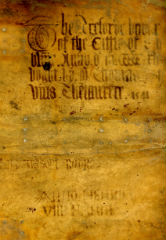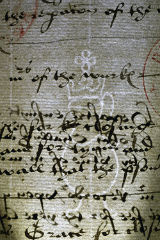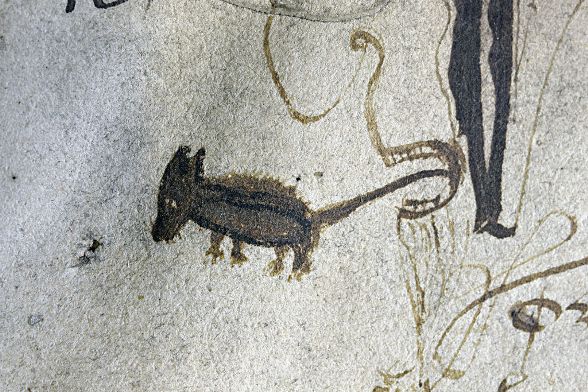Dublin City Treasurer's Account Book (1540-1613)
Published on 1st September 2016
 On 16 November 1538, the Monastery and lands of All Hallows were surrendered by Prior Walter Handcocke to Henry VIII as part of the Dissolution of the Monasteries. The house and lands of All Hallows were granted by the king to the Mayor, Bailiffs, Commons and Citizens of Dublin on 4 February 1539. The lands included properties in counties Dublin, Meath, Kildare, Louth, Tipperary, Kilkenny and elsewhere. The grant of All Hallows more than doubled the city’s land-bank and led to a reorganization of the Dublin City Treasurer’s office to cope with the increased revenue from leases of All Hallows land. This, the earliest known City Treasurer’s Account Book begins in 1540 largely as a way of ensuring that all moneys from letting this land bank were accounted for.
On 16 November 1538, the Monastery and lands of All Hallows were surrendered by Prior Walter Handcocke to Henry VIII as part of the Dissolution of the Monasteries. The house and lands of All Hallows were granted by the king to the Mayor, Bailiffs, Commons and Citizens of Dublin on 4 February 1539. The lands included properties in counties Dublin, Meath, Kildare, Louth, Tipperary, Kilkenny and elsewhere. The grant of All Hallows more than doubled the city’s land-bank and led to a reorganization of the Dublin City Treasurer’s office to cope with the increased revenue from leases of All Hallows land. This, the earliest known City Treasurer’s Account Book begins in 1540 largely as a way of ensuring that all moneys from letting this land bank were accounted for.
Image: Grotesque, City Treasurer's Account Book. Dublin City Library & Archive MR/35 (1540-1613)
In the period covered by this book, the Dublin City Treasurer was usually an Alderman on the Dublin City Assembly who was appointed for an initial period of a year, often renewed. The City Treasurer presented the accounts to the Assembly each year at the fourth Friday after Michaelmas (St. Michael’s Day, 29 September). The book was conserved in the late 19th century, most probably under the direction of Sir John T. Gilbert (who also gave directions that ‘Dublin Corporation’ should be stamped on each page as a security measure, as was done in Les Archives Nationales de France). It was re-bound in reverse calf (now much degraded) and two large bands were applied, one to the head and one to the end of the spine.
 The front of the original cover has been bound into the front of the book. This is in finely-tanned leather, possibly sheepskin and the holes from the original clasps can be clearly seen. At the top is written (in English):
The front of the original cover has been bound into the front of the book. This is in finely-tanned leather, possibly sheepskin and the holes from the original clasps can be clearly seen. At the top is written (in English):
The Tresorye booke
of the Cittie of Du-
bline Anno d[omini] MDXLI
boght by Thomas Ste
vins Thresaurer 1541
Image: Front cover, City Treasurer's Account Book (click to enlarge)
Inside the pages of the book are made of paper and this is the earliest document in the City Archives where paper is used. Paper was first made in China during the Han Dynasty (202 BC to 220 AD). The techniques for making paper reached Europe in the 11th century but spread very slowly, reaching England in 1488. These early papers were made by hand, using cotton and linen rags, which means that they have survived well until the present day. As essentially it’s made of cloth, early paper can be washed if necessary – a procedure which has to be done by a trained paper conservator. (Modern papers are made of wood pulp, usually eucalyptus, which is imported largely from Australia).
 The paper in the City Treasurer’s book appears to have been imported from France: Professor Padraig O Maicin has identified just one watermark in the book, on folio 42, which is a decorative urn, often used by paper mills in France to identify their work. The pages have lines down them, a practice which is known as ‘chained paper’ and is like ribbing on a knitted jumper, designed to strengthen each sheet.
The paper in the City Treasurer’s book appears to have been imported from France: Professor Padraig O Maicin has identified just one watermark in the book, on folio 42, which is a decorative urn, often used by paper mills in France to identify their work. The pages have lines down them, a practice which is known as ‘chained paper’ and is like ribbing on a knitted jumper, designed to strengthen each sheet.
Image: Watermark, City Treasurer's Account Book (click to enlarge)
Each page was conserved during the 19th century, with a new edging put onto it using acid-free paper. It is likely that the Treasurer’s Book was suffering from damp as indicated by the staining on some of the pages. The conservator appears to have cut off the worst of the soiled edges – fortunately a substantial margin had been left which means that no text was removed. The numbers throughout the Treasurer’s Book are written in Roman numerals and not in Arabic numerals. Capital letters on some of the pages near to the front of this book have been decorated with grotesques – a sure sign that the scribe entering the accounts was really bored! But in reality researchers have found many stories in the book – they have constructed biographies of many Dublin merchants; described lavish parties held in the city; and recorded visits by the Queen’s Players, a theatre troupe based in London.
Image: Grotesque, City Treasurer's Account Book (click to enlarge)
Manuscript of the Month
Each month, Dublin City Archives will be showcasing a manuscript from their collections on our blog. Check back next month for the next instalment!
See also: Admiral Nelson's casts an eye over the Dublin City Treasurer's Accounts in his latest News from Nelson blog: "Last week I was browsing away and I came across the Dublin City Treasurer’s Accounts 1540-1613. I know – I can hear you say ‘Bor-ring!’ and at first I thought so too." Read more: News from Nelson - Grotesques!
